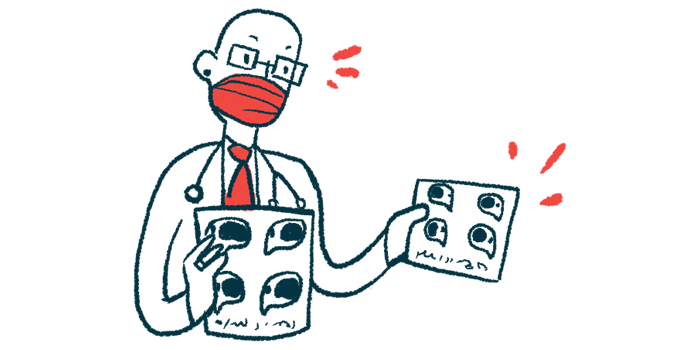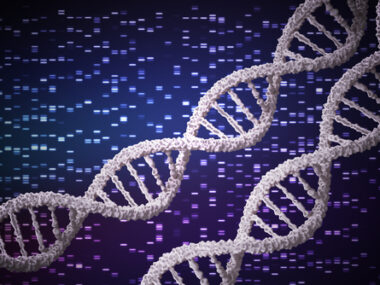Features of Musculocontractural EDS Described for 1st Time in Study
Written by |

An international study involving the largest group of patients worldwide, to date, has for the first time detailed clinical and molecular features of the rare musculocontractural form of Ehlers−Danlos (EDS) syndrome.
This form of the condition is characterized by several malformations and progressive fragility-related symptoms, the study reported.
Titled “Clinical and molecular features of 66 patients with musculocontractural Ehlers−Danlos syndrome caused by pathogenic variants in CHST14 (mcEDS-CHST14),” the study was published in the Journal of Medical Genetics.
EDS is a group of genetic disorders that affect the body’s connective tissue and are characterized by hyper flexibility of skin and joints, as well as by fragile tissues.
Musculocontractural EDS (mcEDS) is a rare type of EDS, sometimes referred to as adducted thumb and clubfoot syndrome, in which patients are born with twisted thumbs and a foot that usually points down and turns in. mcEDS is caused by mutations (variants) in the CHST14 gene, which carries instructions for cells to make an enzyme involved in generating the extracellular matrix — the scaffold of proteins and molecules that provide anchoring points for cells to form tissues.
Although many disease-causing mutations in the CHST14 gene have been reported, little has been known about the spectrum of mutations, the prevalence of various clinical manifestations, and the disorder’s detailed natural history; these have not yet been thoroughly investigated in musculocontractural EDS.
To learn more, a team led by scientists at the Shinshu University Graduate School of Medicine, in Japan, collected clinical and molecular information from 66 mcEDS patients — 33 males and 33 females — from 48 families worldwide. The age of participants ranged from less than one day old to 59 years.
The ethnic origins of the patients were primarily concentrated in Asia, with 27 Japanese families, three Turkish, three Hispanic, and two patients each from Indian, Dutch, and ‘Asian’ families. One patient each had a family that was Austrian, Afghani, Miccosukee, Curaçaoan, Moroccan, Pakistani, Mexican, Thai/German, and Bangladeshi.
In the group analyzed, pregnancies were complicated in 36% of cases, with reduced fetal movement, too little amniotic fluid, and fetal distress. The children were diagnosed with hand and/or foot abnormalities, growth impairment, swelling of one or both kidneys, and brain abnormalities.
Similarly to the pregnancies, deliveries were complicated in 34% of patients, with cesarean sections performed due to fetal distress and breech presentation, in which an infant is position bottom-first instead of headfirst.
Neonatal periods were reported as eventful in 89% of cases due to clubfoot, adducted thumbs, poor suckling or feeding, muscle weakness, heart and lung problems, jaundice, swelling of one or both kidneys, and eye impairments.
The researchers included nine patients in the study; their median survival was 12 years. The causes of death, available for five patients, were respiratory distress shortly after birth, a bacterial infection of the bloodstream (septicemia) due to a scalp hemorrhage at age 12, inflammation of the heart due to infection at 28 years, perforation of the large intestine at age 37, and brain hemorrhage at 59 years.
Head and face features were distinctive, with some becoming less evident or changing with age, according to the study. In early childhood, a round face shape was seen with the lower jaw behind where it should be, which became slender and elongated into adolescence or adulthood, with a protruding jaw, crowded teeth, and asymmetric facial features. These age-related differences were found to be statistically significant.
Other features included broad, bossed, and flat foreheads, dental problems, bushy eyebrows, wide noses, pointed chins, downward turned mouths, and drooping eyelids and face.
Skeletal features also were distinctive, with tapered fingers that were slender, cylindrical, or long, and overlapping. Clubfoot was common, as well as angled and bent limbs. Recurrent dislocation occurred in the shoulders, knees, knee caps, elbows, hips, or fingers. A total of 80% of patients had joint dislocations by the age of 10. Curvature of the spine, a condition known as scoliosis — one of the most commonly reported symptoms of EDS — also was frequently seen among these patients.
Hyperflexible and fragile skin was common, as was sensitivity to pressure, which hindered blood pressure measurements in the upper arms. Recurrent infection under the skin occurred in just over one-third of patients (37%), typically around the buttocks or elbows. Widely spaced nipples, soft, smooth, doughy, and/or velvety skin, and thin and/or translucent skin also were reported.
Large, under-the-skin bruising was a common cardiovascular complication, occurring mainly on the scalp, buttocks, thighs, lower legs, and knees. Overall, 80% of patients with large bruising had their initial episode by the age of 12. Heart abnormalities also were reported.
Constipation was the most common digestive tract problem, followed by abdominal pain, diarrhea, and large bowel sounds.
Failure of the testis to descend was the most common urology abnormality in male patients. Bladder impairment also was reported. Sexual development-related findings included poor breast development and a lack of sex hormones (hypogonadism). The age range of first menstruation was between 12 and 16 among female patients.
Concerning eye defects, the most common were nearsightedness, followed by astigmatism, farsightedness, and lazy eye. Blindness was noted in six participants and hearing loss in 22 patients.
There were recurrent neurological, muscular, and neurodevelopmental manifestations, including structural brain anomalies, tethered spinal cord, and a lack of muscle tone accompanied by motor developmental delay. The median age of independent walking was 26 months, or more than two years. One adult with mcEDS required walking support. In school-age children or older, no significant intellectual disability was noted.
Surgery was performed, planned, or considered in 96% of mcEDS patients for various complications such as clubfoot, retinal detachment, testis descent, significant bruising, spinal deformities, and dislocations. The median number of complications requiring surgery was three per patient. Braces or orthotics were required in 80% of patients for congenital or progressive skeletal complications.
Pharmacological therapies — to include laxatives or medicines for constipation and for preventing bruising, as well as eye drops for glaucoma — were given to 70% of patients. Treatments for bone disease and pain relievers, and antibiotics post-surgery, also were prescribed. In addition, 76% of participants underwent rehabilitation, including physiotherapy.
“In conclusion, this first international collaborative study offers further delineation of clinical and molecular features in mcEDS-CHST14,” the researchers wrote.
The findings demonstrate that the condition “represents a multisystem disorder with [a] unique set of clinical phenotypes consisting of multiple malformations and progressive fragility-related manifestations,” and that “these require lifelong, multidisciplinary healthcare approaches,” the team added.






